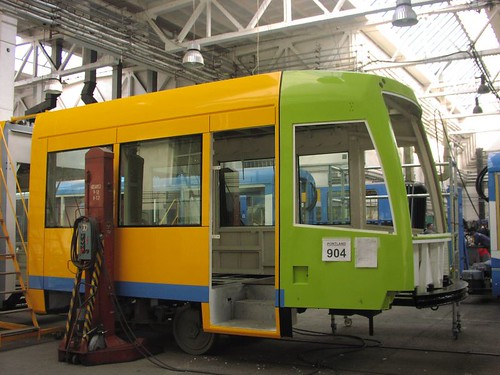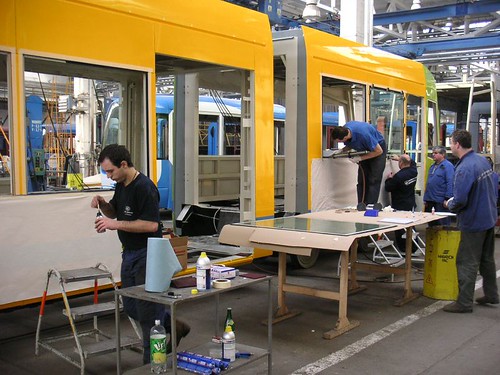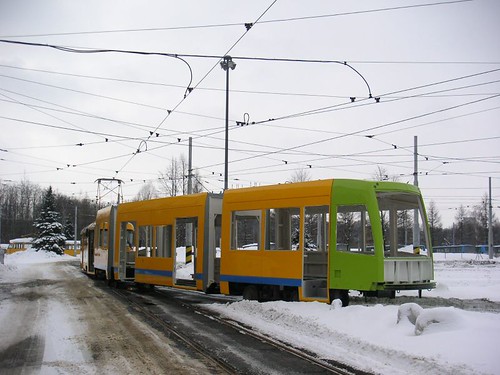During my trip to the Czech Republic last fall, I got to see frames being welded for our next three Streetcars.
We have some photos of recent progress, they’re further along now!
Notice the new colors we’re adding to our palette, Golden Yellow and Apple Green. Look for them on Portland Streets in the fall, after the Gibbs extension opens.
During my trip to the Czech Republic last fall, I got to see frames being welded for our next three Streetcars.
We have some photos of recent progress, they’re further along now!
Notice the new colors we’re adding to our palette, Golden Yellow and Apple Green. Look for them on Portland streets in the fall, after the Gibbs extension opens.



20 responses to “Anticipation is Making Me Wait”
That is awesome.
Does anyone know after they add these cars, will they be able to increase the frequency? I remember them talking about a 7 minute frequency at one point in time (about 1999-2000) but obviously that hasn’t worked out functionally.
I look forward also to my curiosity about these loud thuds the current cars make. The same cars in Tacoma don’t make them, and also are less rackety. I ponder whether these new cars have alleviated any of the problems.
The publicly stated goal is 10 minutes. The fleet of 10 could handle this for the Gibbs extension, but not all the way to Lowell. That would require an 11th car (possibly the Oregon Iron Works prototype car). But the bigger issue is the operating budget. Let TriMet and the City know you want better frequency.
Speaking of noises from the streetcar, does this slightly newer design have a quieter inverter? The current streetcars have quite a high-pitched scream as they go by… and the inverter electronics are highly noisy on the AM band too (compared to MAX)… just tune an AM radio off-station and wait for a streetcar to come anywhere near you.
– Bob R.
Bob, I’m afraid I have no idea about the inverter.
Chris,
Do you have any more information on this Oregon Iron Works prototype car that you mention? I’m kinda curious about it, what it might look like, when it could be expected, how soon other cars might be produced in Oregon…
thanks,
~Garlynn
Nice Ride!
Will the new cars all be of green and yellow?
Jon – No, there are a mixture of colors from the old palette plus the two new colors being added to the palette.
Garlynn – The domestic car is an interesting story in federal process. The background is that Congressman Defazio was able to get $4M earmarked in the last transportation bill. The congressman then held a press conference at Oregon Iron Works announcing the funding.
But… the actual grant is to TriMet, and nothing specifies OIW as the contractor. So TriMet is now going through all the federal regs to figure out how this has to go out to bid, and there are potential manufacturers in other states (with powerful congresscriters of their own) who have indicated a desire to bid.
Stay tuned!
They are looking good.
As for the domestic car, if it was opened to bid, that would be great, more the better. If more modern streetcar systems are proposed, either as stand-alone or as a complement to Interurban Light Rail, it would be a good help if the systems did not have to ask the FTA for a Buy America Act waiver, and competition among domestic bidders might lower the costs, but their needs to be a bigger market first.
Just wondering, could the Skoda’s be modified for Counterbalance Operation. There is talk up here of opening up the Queen Anne Ave Counterbalance Tunnel to tours(but not re-activating the streetcar line that succumbed to the March of Progress in August 1940). It is in the dream stage, and it could go one step further if it came to reality. The tracks would have to be put back in, but as for electrical infrastructure, that might just still be there. If the Skodas can share the power system that the Trackless Trolleys use, the voltage the Trackless Trolleys use is 600V.
http://seattlepi.nwsource.com/local/262625_underground11.html
http://www.davesrailpix.com/odds/wa/htm/smr04.htm
http://www.davesrailpix.com/odds/wa/htm/smr03.htm
OK, I’ll bite. What’s counterbalance operation?
Chris –
It usually means that there is a grade too steep for a streetcar to make it up under its own power, usually a continuous grade in one direction for the entire length of the line.
One vehicle is permanently tied (think like a big rope tow) via a pulley at the top of the hill to another vehicle. As one goes up the hill, the other counter-balances it by going down.
Another way to look at it is that it is basically an Aerial Tram running on the ground using streetcars. :-) (Ducking)
– Bob R.
Believe it or not, that article fromt he PI I included in the post and the two photo links, was about all I could find on the Coutnerbalance. They worked in a few other cities until tunnels or other devices were employed. The Skodas could be the leading candidates for the South Lake Union line, using the fact that they have the solid footing of Tacoma and Portland. Could allow for parts trade if need be.
As far as the loud racket that the streetcars make, this is apparently due (according to some of the drivers) to the fact that some of the streetcars have unevenly-worn wheels – flat wheels.
Not all of them make noise, a couple are super-quiet. Kind of odd, though.
I’d attest to that probably being the wheels.
When a passenger train gets a flat spot, or freight. It’s easily 10x worse because of the size.
I wonder though how the streetcars so easily got flat spots?
Also – Speaking of noise. The 100+ year old streetcars that are run here in PDX, Memphis, and New Orleans ALL make vastly less or no noise besides the regular wheels on steel sounds.
I’d rather see a local company (such as the one that built the 24 New Orleans Streetcars at 800k a piece) build some “modern” looking streetcars instead of continuing to use the Skoda cars. I’m not trying to be mean, but they’re really unimpressive being they are about 5 years old and already this rackety.
Grinding the wheels is a regular maintenance activity for Streetcar.
How are the Skoda’s not modern-looking?
Jon wrote: “How are the Skoda’s not modern-looking?”
Jon –
I _think_ what Adron meant was that another vendor should build some streetcars which look “modern” just like the Skoda cars look modern, rather than building historical replica cars.
– Bob R.
Too Bad Brill, Pullman-Standard and St. Louis Car were driven out of the Streetcar Buisness between 1941 and the early 1950s. The PCC, and the Brilliner were pretty interesting streamlined designs. Not sure what they would have designed if they were stil in buisness today. I do wonder what Aerodynamic styled streetcars would be built today if Aerospace firms got in on the design, but BOEING tried and failed in the 1970s.
As for New Orleans, the Canal St. Cars were built at Carrolton Station, which is the carbarn for the St. Charles Line. Katrina did major damage to the St. Charles Line, but Carrolton escaped flooding while Randolph Station did not, flooding the Red Cars of the Canal Line up to their fareboxes. Service on the Riverfront and Canal St Lines were restored using a few of the old cars of the St. Charles Line.
EvergreenTransitFan wrote: “BOEING tried and failed in the 1970s.”
Indeed… anyone with complaints about the current Skoda streetcars (including me) would do well to experience a Boeing-Vertol LRV. These were quite possibly the worst thing ever to run on rails in the history of transportation.
Used by San Francisco and Boston from the late ’70s through mid ’90s and beyond. Just awful. Noisy mechanically and electrically (the inverter whine actually came through on the PA system), and inherently unreliable. At crush load, the body would sag so much that some doors would not open as their mechanisms became misaligned.
The Breda cars now used in San Francisco, although substandard by some measures, are a vast improvement over the Boeing-Vertols. May they rest (and stay rested) in peace.
Oregon Iron Works, or whoever gets the contract, would do well to study the lessons of this design disaster.
Article Link:
http://en.wikipedia.org/wiki/US_Standard_Light_Rail_Vehicle
Article Link with Photo:
http://www.transit-rider.com/lrt/boeing.cfm
– Bob R.
If one is interested in riding a Boeing LRV look no further than Brooks, OR. I’m glad they saved one eventhough they were lemons because they are an important piece of modern transit history.
I agree with that the should build a modern looking car not a replica car, sorry I misunderstood your comment adron. But at the same time they should probably keep it rather simple. The PCC would be a good place to start but of course modern day styling… a sleekcar
Although the reason a $2.5 million grant for the South Lake Union line up here was denied was not over the vehicle choice, but the fact that the money had been earmarked for an emergency, I still think it is a great idea that their be an American Builder of these vehicles.
http://seattlepi.nwsource.com/opinion/262757_runteparks14.html
Also, Skoda has a sleek looking design on their website, with the styling done by Porshe. Too bad the Auto COmpanies here do not have great designers as good as the legends of 30-60 years ago. Would be ironic that automobile designers could design a modern car, or at least style them.